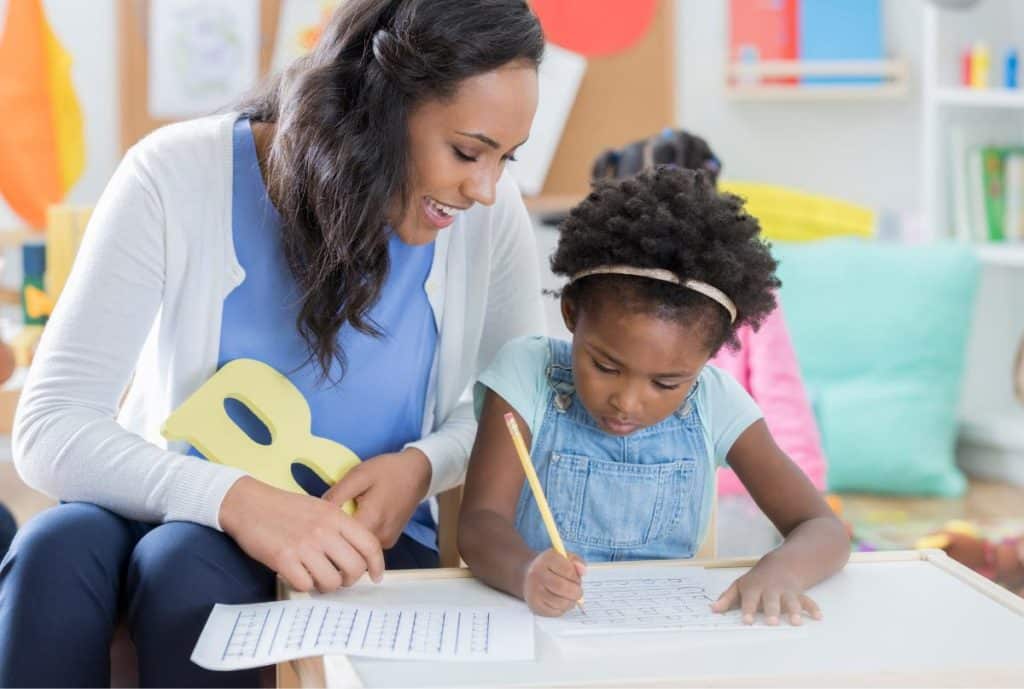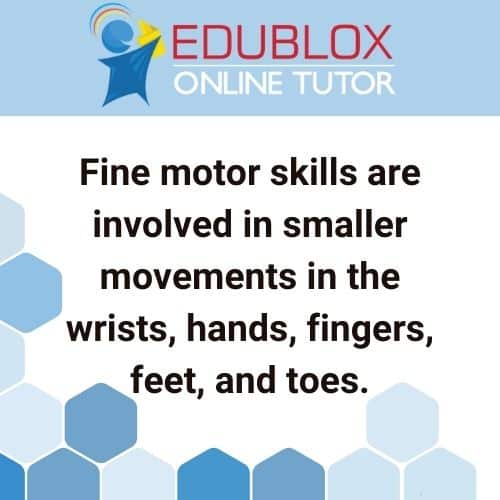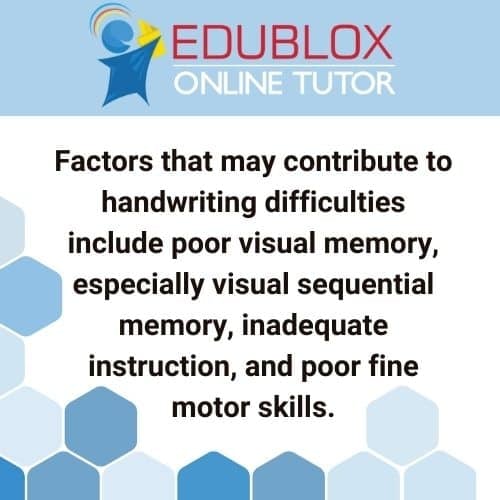
Failure to attain handwriting competency often adversely affects academic success and self-esteem. The two most essential elements in handwriting performance are legibility and speed. Factors contributing to deficiencies in penmanship include poor fine motor skills, which is the focus of this article.
Why handwriting matters
Handwriting is often judged and seen as a reflection of an individual’s intelligence or capabilities. Studies show lower marks are assigned to students with poor handwriting and higher marks to those with legible handwriting despite similar content.
Children with handwriting problems typically have difficulty keeping up with the volume of written work required during the elementary school years, which may impede academic progress and lead to lowered self-esteem and behavioral problems. In addition, it is common for these children to be wrongly labeled as noncompliant, lazy, or lacking motivation, which causes further frustration and disappointment (Feder & Majnemer, 2007).
Factors that may contribute to handwriting difficulties include poor visual memory, especially visual sequential memory (Tseng & Chow, 2014), inadequate instruction (Graham & Miller, 1980), and poor fine motor skills (Seo, 2018).
What are fine motor skills?
Motor skills are movements and actions of the muscles. Typically, they are categorized into two groups: gross and fine motor skills.
Gross motor skills are involved in the movements of the arms, legs, and other large body parts. They participate in actions such as crawling, running, and swimming.

Fine motor skills, on the other hand, are involved in smaller movements in the wrists, hands, fingers, feet, and toes. For example, they participate in smaller actions such as picking up objects between the thumb and finger, writing carefully, and even blinking.
These two motor skills work together to provide coordination.
Fine motor skills are essential for performing everyday skills like self-care tasks (e.g., clothing fastenings, opening lunch boxes, cleaning teeth, using cutlery) and academic skills (e.g., writing, drawing, coloring, cutting, and pasting). Without the ability to complete these everyday tasks, a child’s self-esteem may suffer, and academic performance may be compromised. They may also be unable to develop appropriate independence in life skills, such as getting dressed and feeding themselves.
Although some children do well at gross motor activities, their performance in fine motor activities may be poor.
Building blocks of fine motor skills
The building blocks necessary to develop fine motor skills are (Childdevelopment.com.au):
* Bilateral integration: Using two hands with one hand leading (e.g., opening a jar lid with one hand while the other helps by stabilizing the jar).
* Crossing the mid-line: The ability to cross the imaginary line from a child’s nose to their pelvis that divides the body into left and right sides.
* Hand and finger strength: An ability to exert force against resistance using the hands and fingers that allows the necessary muscle power for controlled movement.
* Eye-hand coordination: The ability to process information from the eyes to control, guide, and direct the hands in performing a task such as handwriting.
* Hand dominance: The consistent use of one (usually the same) hand for task performance, which allows refined skills to develop.
* Hand division: Using just the thumb, index, and middle fingers for manipulation, leaving the fourth and little fingers tucked into the palm, not participating but providing stability for the other three fingers.
* Object manipulation: The ability to skillfully manipulate tools (such as the ability to hold and move pencils and scissors with control) and the controlled use of everyday devices such as a toothbrush, hairbrush, and cutlery.
* Body awareness (proprioception): Information that the brain receives from our muscles and joints to make us aware of our body position and body movement, so we can accurately control our movements.
How to identify poor fine motor skills
If a child has difficulties with fine motor skills, they might:
* Have an awkward or immature pencil grasp for their age.
* Have poor handwriting; their writing may be messy, slow, or laborious.
* Quickly fatigues when typing or using a mouse on a computer.
* Have difficulty when using scissors.
* Have difficulty performing precise manipulation tasks, for example, using a spoon or fork, buttoning their clothes, or tying shoelaces.
* Have difficulty performing age-appropriate self-care tasks independently.
* Easily tires when engaging in fine motor tasks.
Fine motor activities
In her book Learning Disabilities, Janet Lerner lists many activities to improve fine motor skills and groups them into (1) throwing and catching activities and (2) eye-hand coordination activities.

Throwing and catching activities:
* Throwing. In throwing objects at targets or the parent, the child can use balloons, wet sponges, beanbags, yarn balls, and rubber balls of various sizes.
* Catching. Catching is a more difficult skill than throwing; the child can practice catching the above objects thrown by the parent.
* Ball games. Many ball games help in the development of motor coordination. Some examples are playing balloon volleyball or rolling ball games, bouncing balls on the ground, and throwing balls against the wall.
* Tire tube games. Old tire tube games provide suitable objects for games of rolling and catching.
* Rag ball. Many children find that throwing and catching a rubber ball is too difficult a task. So, initially, a rag ball can be used, which can be made by covering rags or discarded nylon hosiery with a cloth.
Eye-hand coordination activities:
* Tracing. Have the child trace lines, pictures, designs, letters, or numbers on tracing paper, plastic, or stencils. Use directional arrows, color cues, and numbers to help them trace the figures.
* Water control. Ask the child to carry and pour water into measured buckets from pitchers to specified levels. Use smaller amounts and finer measurements to make the task more difficult. Coloring the water makes the activity more interesting.
* Cutting with scissors. Have the child cut with scissors, choosing activities appropriate to their needs. The easiest task is cutting straight lines marked near the edges of the paper. The child should also be asked to cut straight lines across the center of the paper. Some might need a piece of cardboard attached to the paper to guide the scissors. Next, have the child cut out marked geometric shapes, such as squares, rectangles, and triangles. You can draw lines in different colors to indicate direction changes in cutting. Next, have the child cut out curving lines and circles, then pictures, and finally, patterns made with dots and faint lines.
* Stencils or templates. Have the child draw outlines of patterns of geometric shapes. Templates can be made from cardboard, wood, plastic, old x-ray films, or containers for packaged meat. Two styles can be made: a solid shape or frames with the shape cut out.
* Lacing. A piece of cardboard punched with holes or a pegboard can be used for this activity. A design or picture is made on the board, and the child follows the pattern by weaving or sewing through the holes with a heavy shoelace, yarn, or cord.
* Paper and pencil activities. Coloring and dot-to-dot books frequently provide good paper-pencil activities for fine motor and eye-hand development.
* Jacks. The game of jacks helps develop eye-hand coordination, rhythmical movements, and fine finger and hand movements. Visit this page to learn the rules.
* Clipping clothespins. Clothespins can be clipped onto a line or a box. The child can be timed in this activity by counting the number of clothespins clipped in a specified time.
* Copying designs. The child looks at a geometric design and copies it onto a piece of paper.
.

